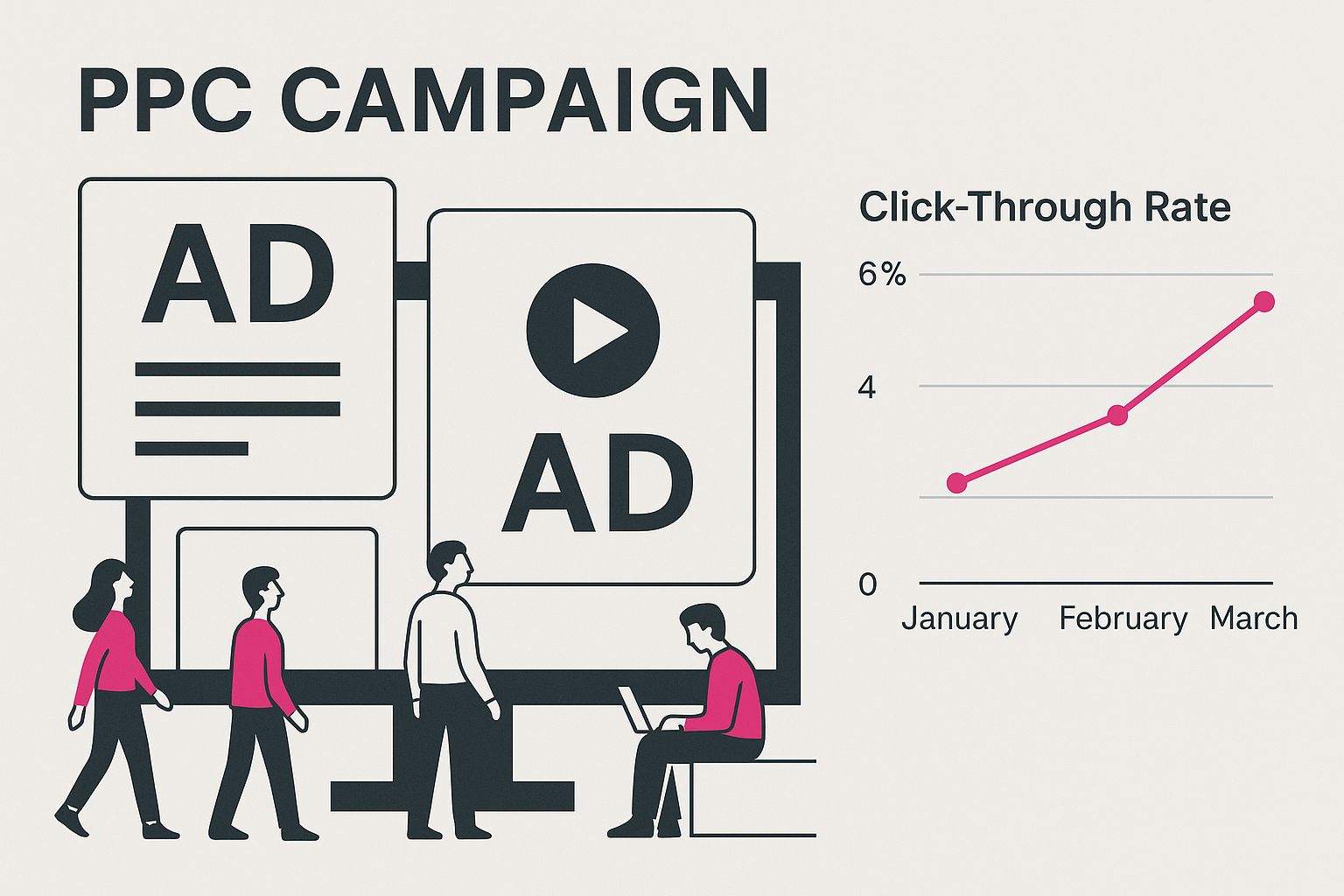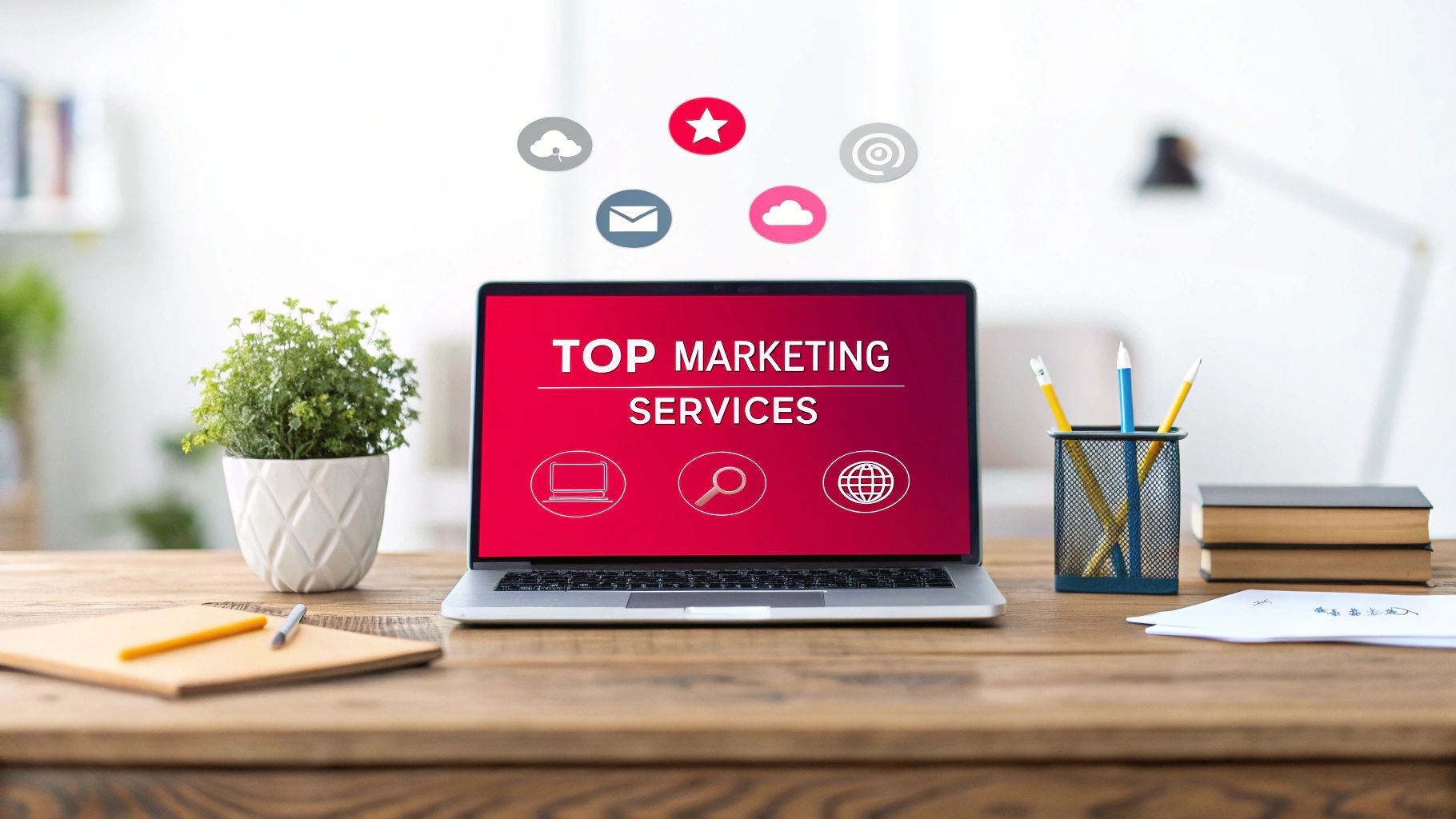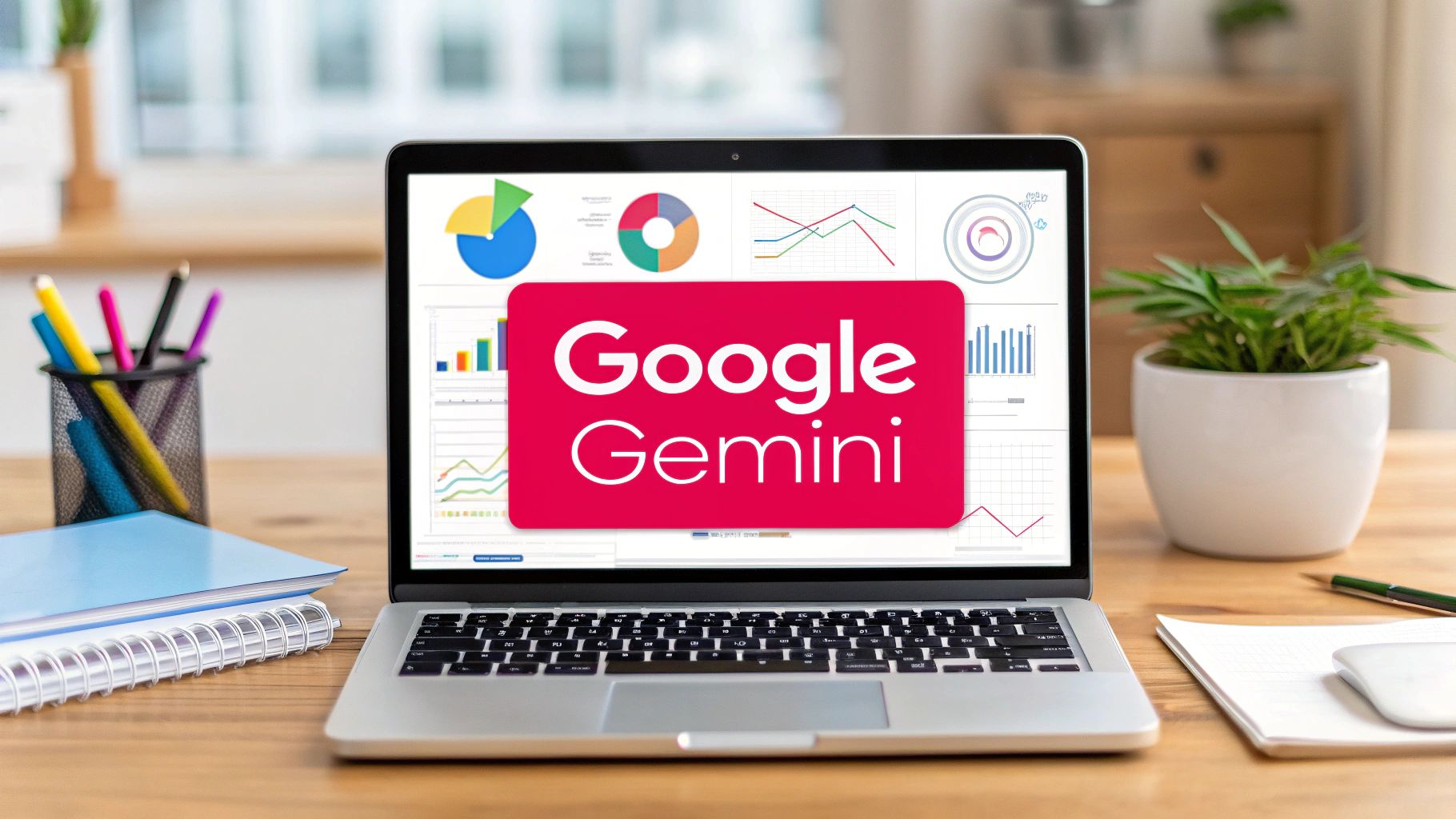The term services in digital marketing really just means all the specialised strategies we use to connect with customers online. Think of them as the individual tools in a marketer’s toolkit. Each one is designed to hit a specific business goal, whether that’s getting more eyes on your brand or directly driving sales.
Your Guide to Digital Marketing Services
Trying to build a business online is a lot like building a house. You wouldn't use just a hammer for the entire job, right? You need a whole toolbox filled with specific tools for framing, plumbing, and electrical work. Digital marketing services are those specialised tools, and they all work together to construct a solid, lasting online presence.
Let's break down that analogy. Search Engine Optimisation (SEO) is your foundation; it makes sure people can actually find you when they’re looking for what you do. Your website is the structure itself—the digital storefront for your brand.
Then you have your content, like blog posts and videos. That's the interior design that makes your "house" welcoming and valuable to anyone who stops by. And social media? That’s how you throw an open house, inviting people in, starting conversations, and building a community around your brand.
The Synergy of a Modern Strategy
Each service has its own job, but the real magic happens when they work together. A brilliant blog post (content marketing) won't do much good if no one can find it. That’s where SEO comes in to make it discoverable and social media comes in to promote it.
In the same way, a paid ad campaign is a hundred times more effective when it sends people to a website that’s easy to use and persuasive. It's all connected.
This guide will walk you through the core services every business needs to know:
- Search Engine Optimisation (SEO) for building long-term, organic visibility.
- Pay-Per-Click (PPC) Advertising for getting immediate, targeted traffic.
- Content & Social Media Marketing to engage your audience and build your brand.
- Email Marketing & Automation for nurturing leads and customer relationships.
- Analytics to measure what’s working and make smarter decisions.
Our goal here is to cut through the jargon and give you a clear framework for figuring out where to invest your marketing pounds. This is about moving from guesswork to a predictable plan for growth.
And if you really want to stand out, a great next step is learning about the power of marketing personalization, which can seriously amplify your results across all these channels.
SEO: The Foundation of Your Online Visibility

When you look at all the services in digital marketing, Search Engine Optimisation (SEO) is the bedrock of long-term success online. Think of it as the methodical process of making your website more attractive to search engines like Google. In simpler terms, good SEO helps potential customers find you naturally, without you having to pay for every single click.
Let's use an analogy. Imagine the internet is a massive, ever-expanding library, and your website is one book among millions. Without SEO, your book is lost on a dusty bottom shelf. But with a solid SEO strategy, it’s properly catalogued, placed in the right section, and even recommended by the librarian whenever someone asks about your topic.
This isn't about trying to trick search engines. It's about providing an excellent experience for your visitors and clearly communicating your website's value. When done right, SEO builds trust and authority, attracting a steady stream of relevant traffic that actually grows over time.
The Three Pillars of Modern SEO
So, how does it all work? The best way to understand SEO is to break it down into its three core components. Each pillar supports the others, and if one is weak, the whole structure can wobble. A truly effective strategy needs to address all three at once.
These pillars are:
- On-Page SEO: Everything you do on your website to improve its ranking.
- Off-Page SEO: All the actions taken away from your website to build its reputation.
- Technical SEO: The behind-the-scenes work that helps search engines find and understand your site.
Let’s dig into what each of these really means for your business.
On-Page SEO: Optimising Your Content
On-page SEO is all about the content that lives on your website and how you organise it. The goal is to make it crystal clear to both people and search engine bots what your pages are about. It all starts with keyword research—figuring out the exact words and phrases your ideal customers are typing into Google.
Once you have those keywords, you strategically weave them into key places on your website, including:
- Page titles and meta descriptions
- Headings and subheadings (like the ones on this page)
- The main body text and even image descriptions (alt text)
For example, a local bakery in Dubai wouldn't just talk about "cakes." Their research might show that people are searching for "vegan birthday cakes in Dubai Marina" or "custom wedding cake delivery UAE." By creating pages that specifically target these longer, more detailed phrases, they answer a direct need, making their content far more valuable and much more likely to rank high in search results.
Off-Page SEO: Building Authority and Trust
Off-page SEO is primarily about building your website's authority, and the main way to do that is through backlinks. A backlink is essentially a vote of confidence from another website. When a reputable, relevant site links to your content, it’s a powerful signal to Google that your website is a trustworthy resource.
SEO is a long-term investment. Unlike paid ads that stop when you stop paying, the authority and traffic built through consistent SEO efforts become a sustainable business asset that compounds over time.
The more high-quality "votes" you collect, the more authoritative your site appears. This is absolutely critical for climbing the search rankings, especially in competitive fields. You can learn more about how a targeted strategy helps businesses by reading our detailed guide on search engine optimisation in the UAE.
Technical SEO: Ensuring a Flawless Foundation
Finally, we have technical SEO. This focuses on the health and performance of your website's infrastructure. You could have the best content in the world, but if your site is slow, insecure, or a nightmare to use on a phone, search engines will be hesitant to send people there.
Key aspects of technical SEO include:
- Site Speed: Pages need to load fast. Slow sites frustrate users and cause them to leave.
- Mobile-Friendliness: Your site must look and work perfectly on smartphones and tablets.
- Site Security: Using HTTPS is non-negotiable for protecting user data and building trust.
- Crawlability: You have to make it easy for search engine bots to navigate and index all your important pages.
Together, these three pillars form a powerful, cohesive strategy that drives lasting organic growth and establishes your brand as a visible and trusted leader in your industry.
PPC Advertising for Immediate and Targeted Reach
While SEO is the long game for building your brand’s authority, Pay-Per-Click (PPC) advertising is your go-to for making an immediate splash. It's one of the most direct ways to get your products or services in front of customers the exact moment they’re looking for them.
Think of it as renting a premium billboard on the world's busiest digital motorway. You get a prime spot, right away.
Unlike organic search results, PPC lets you jump to the top of the page almost instantly. And as the name implies, you only pay when someone actually clicks your ad. This model gives you incredible control over your budget and is a super-efficient way to drive highly targeted traffic straight to your website.
The real magic of PPC is its precision. You can zero in on potential customers based on the exact keywords they type into a search bar, where they live, their age, their interests—even their past online behaviour. This ensures you’re not just shouting into the void; you're speaking directly to people who are already primed to listen.
How PPC Campaigns Work
At its core, search-based PPC on platforms like Google Ads runs on a lightning-fast auction system. Every single time someone searches for a keyword you’re bidding on, an auction takes place in milliseconds. This determines which ads are shown and in what order they appear.
But it’s not just a highest-bidder-wins scenario. These platforms also look at your ad’s Quality Score, which is basically a rating of how relevant and helpful your ad is to the user. A high Quality Score can actually earn you better ad placements for a lower cost, because platforms want to reward advertisers who create a great experience for their users.
Getting a campaign off the ground involves a few key steps:
- Keyword Research: Figuring out the exact search terms your ideal customers are using.
- Ad Creation: Writing snappy, compelling ad copy that makes people want to click.
- Landing Page Optimisation: Making sure the page users land on after clicking your ad is relevant, easy to navigate, and designed to convert them into a customer or lead.
- Bidding: Deciding the maximum amount you're willing to pay for a single click.
This infographic captures how a PPC campaign acts like a spotlight in a bustling digital marketplace, grabbing attention right away.

As you can see, in a crowded online world, a well-placed PPC ad cuts through the noise like a bright, clear sign, instantly capturing the interest of your target audience.
Different Types of PPC Ads
PPC isn't a one-size-fits-all tool. The right type of ad really depends on your specific goals and, most importantly, where your audience hangs out online.
- Search Ads: These are the classic text ads you see at the top of Google’s search results. They’re perfect for snagging high-intent users who are actively searching for a solution you provide.
- Display Ads: Think visual—these are the image or video ads that pop up on websites across the internet. They're fantastic for building brand awareness and for retargeting, which means showing your ads to people who have visited your site before.
- Shopping Ads: An absolute must for any e-commerce business. These ads showcase a product image, title, and price directly in the search results, giving shoppers all the key info at a glance.
- Social Media Ads: Platforms like Meta (home to Facebook and Instagram) and LinkedIn have incredibly powerful PPC options. Here, you can target users based on extremely detailed demographic data, interests, and professional roles.
To help you decide where to start, here's a quick comparison of the major players.
Comparing Major PPC Advertising Platforms
| Platform | Primary Audience | Ad Formats | Best For |
|---|---|---|---|
| Google Ads | Users actively searching for information, products, or services. High purchase intent. | Search, Display, Shopping, Video (YouTube), App | Capturing immediate demand, lead generation, e-commerce sales. |
| Meta Ads | Users based on interests, demographics, and behaviours on Facebook & Instagram. | Image, Video, Carousel, Stories, Messenger | Building brand awareness, community engagement, driving website traffic. |
| LinkedIn Ads | Professionals based on industry, job title, company size, and skills. | Sponsored Content, Message Ads, Text Ads, Dynamic Ads | B2B lead generation, professional services, high-ticket sales. |
| TikTok Ads | Younger, highly engaged audience interested in trends and entertainment. | In-Feed Videos, Brand Takeovers, TopView Ads | Reaching Gen Z, viral marketing, brand personality campaigns. |
Choosing the right platform—or combination of platforms—is fundamental to getting the results you want.
The true advantage of PPC is its measurability. You can track every single pound spent, monitor your return on investment (ROI) in real-time, and make data-driven adjustments to improve performance continuously.
The regional market certainly reflects this growth. Digital ad spending in the Gulf Cooperation Council (GCC) has exploded, with companies investing $5.5 billion in 2022. That figure is projected to skyrocket to $25.5 billion by 2024, with smartphones accounting for 55.36% of ad delivery, underscoring just how critical mobile-first strategies have become.
Managing these moving parts requires real expertise, and working with specialists can make all the difference. If you're ready to dive in, our guide on choosing from the top PPC advertising companies offers valuable insights on finding the right partner for your business.
Content and Social Media Marketing to Build Your Brand

If SEO is the foundation of your digital house and PPC is the shortcut to the front door, then content and social media are the conversations happening inside. They are the heart and soul of your brand's online personality.
These two services work together beautifully. Content gives your brand a voice—a way to share what you know and what you stand for. Social media then provides the perfect stage for that voice to be heard, shared, and discussed by the people who matter most.
Think of your content marketing as becoming a publisher. You’re creating your own high-quality magazine, and the goal isn't to cram a sales pitch onto every page. Instead, you're focused on creating genuinely helpful, interesting, or entertaining material that your ideal customers actually want to read.
When you consistently provide that value, you earn something far more important than a quick sale: you earn trust, attention, and loyalty. It shifts the entire dynamic from a one-time transaction to a real relationship. Suddenly, you're not just a seller; you're the helpful expert they turn to.
Building a Valuable Content Strategy
A solid content strategy always starts with a simple but powerful question: "What are my customers' biggest headaches, and how can I help them?" When you start answering their questions and solving their problems, you naturally build authority and become a go-to resource.
The content you create can come in all shapes and sizes, and a smart strategy mixes it up to keep things fresh and appeal to different people.
- Blog Posts and Articles: These are your workhorses. Perfect for showing off your expertise, targeting keywords for search engines, and giving detailed answers to common customer questions.
- Videos: Nothing grabs attention like video. It’s fantastic for tutorials, behind-the-scenes looks at your business, and telling your brand’s story on platforms like YouTube or Instagram.
- Infographics: Have a lot of data or a complex idea? An infographic makes it visual, easy to understand, and incredibly shareable.
- Ebooks and Whitepapers: These are your deep dives. You offer a ton of value in exchange for an email address, making them a fantastic tool for generating leads.
By consistently creating great stuff, you build a library of assets that works for you 24/7, pulling in new visitors and nurturing relationships long after you hit "publish."
Social Media as Your Community Hub
So, you’ve created all this amazing content. Now what? You have to get it in front of the right people, and that's where social media marketing shines. It’s so much more than just scheduling posts. It’s about distribution, conversation, and community.
Platforms like LinkedIn, Instagram, and X (formerly Twitter) are not just places to post links. They are where your brand's personality comes alive. You can have direct conversations, get instant feedback, and build a tribe of loyal followers who feel connected to your mission.
A successful social media presence isn't about the number of followers you have; it's about the quality of your engagement. It’s a two-way street where your audience feels heard, appreciated, and part of your story.
A winning strategy uses a mix of organic and paid approaches. Organic posts are for building that genuine relationship with your existing followers. Paid social ads, on the other hand, let you reach a whole new audience, targeting them with incredible precision based on their interests and behaviours. If you're looking to master this, our guide to a social media marketing service breaks down how to craft campaigns that truly connect.
The Power of Working in Tandem
The real magic happens when these services stop working in silos and start working together. A blog post (content) gets found on Google (SEO), is promoted through an Instagram story (social media), and encourages people to sign up for your newsletter (email marketing).
Each piece of the puzzle strengthens the others, creating a seamless journey for your customer. For instance, that video tutorial you posted on YouTube can be embedded in a blog post for more detail. You can then pull key stats from it to create an infographic for Pinterest and slice up short clips for Instagram Reels. This way, you squeeze every last drop of value out of a single piece of content.
This integrated approach makes sure your message is consistent everywhere your customers find you. It’s how you build a strong, recognisable brand that doesn't just attract customers—it creates genuine fans.
8. Nurturing Customers with Email Marketing and Automation
While grabbing attention on social media and search is great for finding new people, email marketing is where you build real, lasting relationships. Think of it less as a megaphone and more as a direct, one-on-one conversation with your biggest fans—the people who actually asked to hear from you.
Unlike social media, where you're at the mercy of ever-changing algorithms, an email lands exactly where you send it: their inbox. This direct line makes it one of the best tools for gently guiding someone from a curious visitor to a loyal customer.
How to Build and Engage an Email List That Cares
A great email strategy starts with a list of people who genuinely want to be there. This means you have to earn your subscribers, not buy them. Offer something truly valuable in return for their email address—a helpful guide, an exclusive discount, or a first look at a new product.
Once they're on your list, the magic is in making them feel seen. You wouldn't talk to a first-time visitor the same way you'd talk to a customer who's been with you for five years, right? That’s where segmentation comes in. By grouping your audience based on things like what they've bought, what they've shown interest in, or even how they signed up, you can send messages that feel personal and relevant.
A great email campaign nails three things:
- A killer subject line that makes them want to click, without being clickbait.
- Content that actually helps them, whether it’s educational, entertaining, or solves a problem.
- A clear call-to-action (CTA) so they know exactly what you want them to do next.
Putting Your Communication on Autopilot
Now for the really powerful part. Marketing automation is like having a super-efficient assistant working for you around the clock. It uses smart software to automatically send the perfect message to the right person at just the right time, without you having to manually press "send" every time.
Imagine setting up a series of pre-planned messages that are triggered by what your users do. This allows you to scale your conversations and make sure no one gets forgotten.
Marketing automation turns your communication from a one-time broadcast into an ongoing, personal dialogue. It’s how you nurture relationships with thousands of people at once, driving sales and building loyalty with messages that feel like they were written just for them.
For instance, when someone new joins your list, you can set up an automated "welcome series" that introduces them to your brand over a few days. Or, if a shopper leaves items in their cart, an abandoned cart reminder can pop into their inbox a few hours later to gently nudge them back—a simple trick that can recover a surprising amount of lost sales.
The incredible growth in this area tells you everything you need to know. The Middle East digital marketing software market alone hit a staggering USD 3,893 million in 2024 and is expected to soar to USD 12,391 million by 2033. Businesses are pouring money into these tools because they work. You can get more details on this rapidly growing market on imarcgroup.com.
By pairing thoughtful, personal emails with smart automation, you create a powerhouse for your business. It’s a system that doesn’t just convert new leads but also keeps your current customers happy, turning them into repeat buyers and your best advocates. It remains one of the most cost-effective services in digital marketing with the highest returns.
Using Analytics to Measure Your Marketing Success
Without data, digital marketing is just a shot in the dark—and an expensive one at that. Analytics is what turns on the lights. It acts as the navigation system for your entire strategy, transforming a flood of confusing numbers into a clear roadmap showing you what's working, what's not, and where your money is actually making a difference.
Think of it this way: launching a campaign without analytics is like driving a high-performance car with a blindfold on. Sure, you’re moving fast, but you have no idea if you’re even on the right road. Analytics takes off the blindfold, giving you the hard data needed to make smart decisions and prove a real return on your investment.
This process isn't just about spreadsheets and charts; it's about turning raw data into a story about your business. You can see exactly how people find your website, what pages they linger on, and what finally convinces them to become a customer. That kind of insight is pure gold for refining your approach over time.
Turning Data into Actionable Insights
The real power of analytics comes from tracking Key Performance Indicators (KPIs). These aren't just vanity metrics; they are specific, measurable numbers directly tied to your business goals. They help you cut through the noise and focus on what actually drives growth.
A huge part of any successful campaign is being able to accurately gauge its impact. You can get a deeper look into measuring digital marketing effectiveness to see how this works in practice. Indispensable tools like Google Analytics are the go-to here, letting you monitor user behaviour and see campaign results as they happen.
Analytics isn't just about collecting data; it's about asking the right questions. Instead of just noting website traffic, ask "Which blog post brought in the most valuable leads this month?" This is how you find actionable insights.
This simple shift in mindset takes you from passively reporting numbers to actively using them to steer your strategy, making every marketing decision smarter than the last.
Key Metrics to Start Tracking
If you're new to analytics, the sheer volume of data can feel like you're trying to drink from a fire hose. The trick is to start simple. Focus on the metrics that are most closely connected to your bottom line.
Here are a few essential KPIs to get you started:
- Website Traffic: The total number of people visiting your site. This is a basic health check for your online presence.
- Traffic Source: Where are your visitors coming from? Organic search? Social media? Paid ads? This tells you which channels are your heavy hitters.
- Conversion Rate: The percentage of visitors who take a specific action, like buying a product or filling out a contact form. This is the ultimate test of how persuasive your marketing is.
- Cost Per Acquisition (CPA): How much you spend in marketing pounds to get one new customer. Keeping an eye on this is crucial for managing your budget.
Zeroing in on these core numbers will give you a surprisingly clear picture of your performance. It's this exact need for clarity that's causing the Middle East digital marketing analytics market—a key component of services in digital marketing—to see such massive growth. Projections show sales revenue rocketing from USD 90.36 million in 2024 to a staggering USD 322.425 million in 2025. This surge is fuelled by businesses in the UAE and beyond investing heavily to get these kinds of powerful insights.
Got Questions? Let's Talk Digital Marketing
Diving into digital marketing can feel a bit like learning a new language. You've got questions, and that's a good thing. Getting straight answers is the first step toward building a strategy that actually moves the needle for your business.
Let's clear up some of the most common things business owners ask when they're just starting out. My goal here is to cut through the jargon and give you the practical insights you need.
What's the Best Digital Marketing Service to Start With?
For most businesses, the smartest place to start is with the powerful duo of SEO and content marketing. Think of it like building a house. SEO is your solid foundation, working behind the scenes to make sure people can find you when they search on Google. It's a long-term play that builds lasting value.
At the same time, content marketing is what you fill that house with—the valuable, interesting stuff that makes people want to visit and stick around. This establishes your expertise and builds trust. If you need a quick win, you can layer on a targeted PPC campaign to get immediate traffic while your SEO efforts pick up steam.
How Much Should I Actually Budget for This?
There's no magic number here. Your budget really depends on your industry, how fierce the competition is, and what you're trying to achieve. A local plumber might only need a few hundred pounds a month for local SEO to get the phone ringing, while a national e-commerce store could be investing tens of thousands to compete for top spots.
A good rule of thumb is to set aside 5-15% of your total revenue for marketing. What's most important, though, is to start with a figure you're comfortable with. From there, track your return on investment (ROI) like a hawk and double down on what’s working.
This way, you’re not just spending money; you’re making smart investments based on real data.
How Long Does It Take to See Real Results?
This is the big one, and the answer completely depends on the service. The timeline for seeing a return can vary wildly.
- PPC Advertising: This is your fast lane. A well-managed PPC campaign can start bringing in clicks, leads, and even sales almost immediately—sometimes within just a few hours of launch.
- SEO: This one is a marathon, not a sprint. You can expect to see some initial movement in your search rankings and traffic in about 4-6 months. The really substantial, business-changing results usually start kicking in after 6-12 months of consistent work.
- Content & Social Media: You'll see likes and comments almost right away, which is great for engagement. But building a genuine community and a deep library of content that people trust takes time and consistent effort over many months.
At Grassroots Creative Agency, we specialise in creating data-supported strategies that drive real growth. Discover how our services can elevate your brand by visiting https://grassrootscreativeagency.com.








